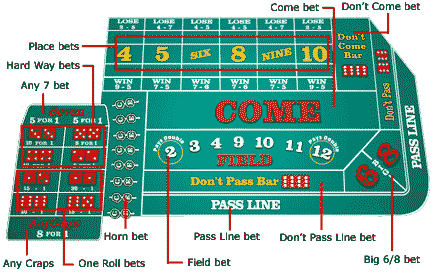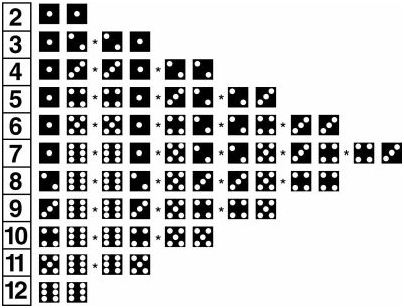
Betting makes a lot of difference to win a game. In the game of Craps you can make lots of different bets to play. The favourite among players of craps is the Pass Line bet. Once you understand this kind of bet the rest of the bets to know becomes easier.
The Betting Sequence
The betting sequence starts with the come-out roll, which is the first roll of the dice. The come-out roll is the time to place Pass bets, by placing a chip or chips on the Pass line directly in front of you, or Don’t Pass bets, by placing a chip or chips on the Don’t Pass bar.
Pass Bets And The Don’t Pass Bets
Pass bets are betting with the shooter, and Don’t Pass bets are against the shooter. A player designated the shooter then flings the dice to the opposite wall of the table. If the come-out roll is 7 or 11, Pass bets win and Don’t Pass bets lose. If the come-out roll is 2, 3, or 12, that’s craps, and Pass bets lose. Don’t Pass bets win on 2 or 3, but 12 is “barred”; Don’t Pass bets neither win nor lose if the come-out roll is 12.
If the come-out is any other number, that becomes the “point.” If the point number is rolled again before the next 7, Pass bets win and Don’t Pass bets lose. If a 7 comes up before the point number, Don’t Pass bets win and Pass bets lose. When the shooter “sevens out” — fails to make the point — the dice are passed to a new shooter. Opportunity to shoot is passed around the table clockwise.
If the shooter is coming out, a plastic disk, black side up with the word “Off” in white, will be placed in a corner of the layout, usually in a box marked “Don’t come.” If the disk has been flipped over to its white side, labeled “On,” and placed in a numbered box, that number is the current point, and the upcoming roll is not a come-out.
Field bets
Field bet is good for any single roll of the dice at any time. The player wins even money if a 3, 4, 9, 10, or 11 is rolled. On most tables a 2 pays double and 12 pays triple. The player loses if a 5, 6, 7, or 8 is thrown.
Likewise, you may bet propositions or hard ways before any roll by putting a chip or chips on the layout and telling the dealer what bet you want.
These bets pay less on “Strip” table layouts.
| Any Craps – 2, 3, or 12 | – | Pays 8 for 1 |
| Any Seven | – | Pays 5 for 1 |
| Eleven | – | Pays 16 for 1* |
| Ace-Deuce | – | Pays 16 for 1* |
| Aces | – | Pays 31 for 1* |
| Twelve | – | Pays 31 for 1* |
The Best Bets
You may bet on any two-dice combination you can imagine But a beginner to this game should limit themselves to the handful of bets that offer the lowest house edge.
Pass/don’t pass Bet
The basic bets in the game also the best bets, especially when coupled with free odds. The house has only a 1.41 percent edge on a Pass bet and 1.4 percent on Don’t Pass. Most players bet the Pass line, partly because they like the camaraderie of rooting for the shooter to make the point. Pass-line players are called “right bettors,” as opposed to the “wrong bettors” who play Don’t Pass and bet against the shooter.
The come-out is the best part of the sequence for a Pass bet. There are six ways to roll 7 with two dice and two ways to roll 11, for eight winning rolls on the come-out. And there are only four losing rolls — one way each to make 2 or 12 and two to make 3. Conversely, the come-out is the danger point for Don’t Pass bets — three ways to win, since the 12 is barred, eight to lose. Once a point is established, the Don’t Pass bet is the favorite to win. Pass/Don’t Pass bets are paid off at even money; that is, a winning $5 bet will return your original $5 plus $5 in winnings.
Come/don’t come Bets
These are the same as Pass/Don’t Pass, except they are placed on rolls other than the come-out. As an example, if 5 is established as the point on the come-out, you may place a Come bet by placing a chip or chips in the area marked “Come.” If the next number rolled is a 7 or 11, the Come bet wins; if it is 2, 3, or 12, it loses; if it is any other number that becomes the point for your Come bet.
If a 9 is rolled, as example, the dealer moves your wager into the box marked “Nine,” and if another 9 is rolled before the next 7, your Come bet wins. If the 7 comes up first, the Come bet loses. If you wish, you may then place another Come bet. Don’t Come bets work exactly like Don’t Pass — they lose if the next roll is 7 or 11, win on 2 or 3, push (neither win nor lose) on 12. If a point number is rolled, Don’t Come bets lose if that number comes up again before the next 7 and win if the 7 comes first.
Free odds Bet
This is paid off at true odds and is the only dead-even bet, with no house edge, in the casino. Once a point is established, a player may back a Pass or Come wager with a bet of an equal amount. This is done by placing a chip or chips directly behind a Pass-line wager. On a Come bet, the player must place the chips on the layout and tell the dealer it is odds on the Come bet. The dealer will move the odds bet into the same box as the Come number.
If the point number is rolled before the next 7, the Pass or Come wager will be paid off at even money, but the odds bet will be paid at true odds of rolling that number — 6-5 on a 6 or 8, 3-2 on 5 or 9, or 2-1 on 4 or 10.
| The Point | Payout | Example |
| 4 and 10 | 2 to 1 | a $5 wager is paid $10 |
| 5 and 9 | 3 to 2 | a $5 wager is paid $7* |
| 6 and 8 | 6 to 5 | a $5 wager is paid $6 |
| * Rounded DOWN from $7.50 on a Strip table layout. “Downtown” layout might pay actualratio of a full $7.50. Strip table layouts do not handle 50-cent pieces. | ||
The combination of a Pass or Come bet with an odds bet lowers the house advantage to .8 percent. Modern casinos commonly offer double odds, in which the player may bet twice his original Pass or Come wager at true odds. This lowers the house edge even more, to .6 percent. Competition has sparked ever-increasing free odds offers. Some casinos accept free odds wagers of five, ten, and even 100 times the pass or come bet.
Don’t Pass/Don’t Come bettors may lay odds after a point is established, giving the house the same odds the house gives a Pass/Come bettor on an odds bet.
As an example, if the point is 4 or 10, a bettor with $5 on the Don’t Pass line can bet another $10 to win $5 if a 7 is rolled before the point (2-to-1 odds). That might not sound like a good deal, but remember that once a point is established, Don’t Come bettors will win more often than they lose. Don’t Come bettors who lay odds also lower the house edge to .7 percent with single odds, .5 percent with double odds.

The possible dice combinations for each number can be seen here. Seven has the best chance of appearing, with six ways that it can be thrown.
Place/buy bets
Instead of waiting for a number to be established for Pass or Come bets, you may place the number by putting chips on the layout and telling the dealer what number you want. If that number comes up before the next 7, you win. The player may ask the dealer to take these bets down at any time, which cannot be done with Pass/Come bets. Pass/Come bets remain in effect until a decision is reached.
After 7, the numbers next most likely to be rolled are 6 and 8. There are five ways to roll each of these numbers, compared with six ways to make 7. So the true odds are 6-5. If the player “places” 6 or 8 in multiples of $6, the house will pay winning wagers at odds of 7-6. That leaves a house percentage of 1.52 percent–not as good as Pass/Come with free odds, but better than most other bets in the casino and an acceptable alternative for a bettor who wants quick action on these two numbers.
The other percentages aren’t as favorable: The casino pays 9-5 on 4 or 10, for a house edge of 6.67 percent, and pays 7-5 on 5 or 9 for an edge of 4 percent.
Placing Bets
| Number bet on | Pays | Example | House Edge |
| 4 or 10 | 9 to 5 | a $5 bet is paid $9 | 6.7% |
| 5 or 9 | 7 to 5 | a $5 bet is paid $7 | 4% |
| 6 or 8 | 7 to 6 | a $6 bet is paid $7 | 1.5% |
Alternatively, the player may “buy” a number by paying the house a 5 percent commission on the wager. In exchange, the casino pays Buy bets at true odds. Since the house edge is less than 5 percent on 5, 6, 8, and 9, it doesn’t pay to buy these numbers. However, buying the 4 or 10 can reduce the house edge to 4.76 percent.
Unless the player tells the dealer his numbers are “working,” Place and Buy bets are usually off on a come-out roll. The bets will stay in the appropriate numbered box, but if the shooter rolls a 6 on the come-out, there will be no payoff for Place bets on 6. This is so that a 7 that’s a winner on the Pass line does not also wipe out all the Place bets.
Watch the Free Odd Bets
